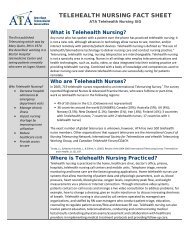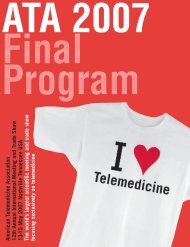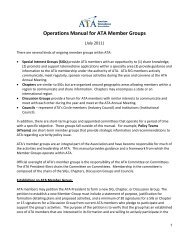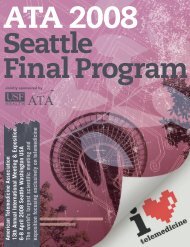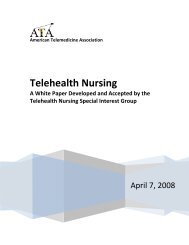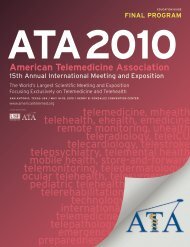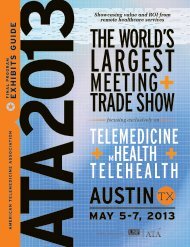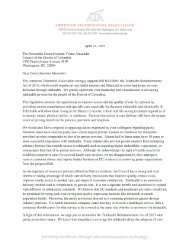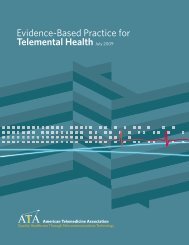Telemedicine
Presentation Abstracts - American Telemedicine Association
Presentation Abstracts - American Telemedicine Association
Create successful ePaper yourself
Turn your PDF publications into a flip-book with our unique Google optimized e-Paper software.
CONCURRENT ORAL PRESENTATIONS ABSTRACTSintroducing new technologies into the health care environment that are appropriateand user specific.Objectives:1. Understand how to apply principles of user centred design to telehealthimplementation and adoption.2. Describe an approach on how to deploy appropriate technology anddesign space based on the clinical user needs.3. Describe how to engage and empower users to incorporate telehealthinto their workflows and practices.79 SPECIALTY CONSULTATION VIA ELECTRONIC COMMUNICATION:THE MAYO CLINIC EXPERIENCEPRESENTERS AND CONTRIBUTING AUTHORS:Lorraine Uthke, MS, MBA, FACHE, Operations Administrator.Mayo Clinic, Rochester, MN, USA.Mayo Clinic has initiated practice redesign initiatives in the outpatientsetting with the objective of reducing cost per episode of care, and compressingthe length of time needed to complete an episode of care so that Mayocan provide access to those patients with complex medical conditions needingface-to-face consultation. Mayo Clinic developed an asynchronous electronichealthcare model to provide consultations between Mayo Clinic providers. AneConsult is a non-visit electronic consultation between a requesting providerand a Mayo Clinic specialist using the Mayo Clinic electronic medical record(EMR) and internal messaging. An eConsult request is initiated by placing anEMR order with a focused, clinical question. The concept was prototyped byMayo Clinic’s Center for Innovation. The focus was on offering asynchronous,electronic medical specialty (cardiology, gastroenterology, pulmonary) consultationto primary care providers as an option to scheduling a traditionalface-to-face visit. This pilot demonstrated an opportunity to reduce the cost tocare for Mayo Clinic’s established and primary care patient population andredirect specialty physician time to more complex patients. The concept wasadvanced to the Mayo Clinic eHealth team for implementation across theoutpatient practice at Mayo Clinic sites in Minnesota, Florida and Arizona. TheeConsult service is limited to asynchronous, electronic interactions and responsesare provided within one business day. Patients are billed for aneConsult and providers are given productivity credit for their effort. eConsultsrequests are now an option available to any Mayo Clinic provider who wouldlike to refer a patient for an electronic consultation, instead of scheduling aface-to-face visit. Common reasons to use eConsults are to save the patienttime and travel, and also more timely access to specialty care that has limitedaccess for traditional outpatient care. To this date, additional work flows arebeing developed as the breadth and depth of the eConsult model for externalaffiliates matures. Adaptation of existing clinical and financial systems andprocesses continue to pose barriers to streamline workflows. Thirty-twohundred eConsults have been provided by Mayo Clinic from January to July of2012. Compliance with the one business day turnaround time is seventy-eightpercent. Primary care providers order the majority of eConsults. Infectiousdiseases, hematology and neurology are the most requested specialties.eConsults are add-on work for specialists, when higher volumes are reachedthey will become scheduled appointments. Seventy-eight percent of physiciansrequesting eConsults strongly agree that eConsults work well withintheir department. Stakeholders strongly endorse eConsults for their efficiency.Physicians also comment that eConsults are not appropriate for all clinicalconditions. Demand for outpatient, specialty eConsults is increasing at asteady rate and requesting provider satisfaction is high. Adaptation of existingscheduling and clinical processes, and financial systems continue to posebarriers to streamline workflows. Dedicated eHealth systems and staffing areneeded to create scalable, sustainable solutions. The adaption of this new caremodel has enhanced the Mayo Clinic model of integrated care while creatingopportunities for cost savings and operational efficiency.Objectives:1. State the key criteria for an electronic specialty consultation requestthat results in requesting provide and patient satisfaction.2. Identify the actions needed to improve adoption of an electronic caremodel to provide specialty care.3. Explain how electronic consultations can reduce the cost to providepatient care and improve provider efficiency.217 THIS TIME ITS PERSONAL: DELIVERING SCALABLE TELEMEDICINESERVICES THROUGH PCS AND MOBILE DEVICESPRESENTERS AND CONTRIBUTING AUTHORS:Ron Riesenbach, MSc, MBA, Vice President, Emerging Business,Anish Shah, BE, MMS.Ontario <strong>Telemedicine</strong> Network, Toronto, ON, Canada.The revolution in consumer electronics has brought powerful mobile devicesand wireless high-speed connectivity to the general public. Levering thistrend is wave after wave of innovation in on-line personal and professionalcollaboration. Healthcare professionals are among the early adopters of thesetechnologies with many now using smart-phones and tablets as part of theirclinical practice. There is no doubt that this revolutions has brought aboutsignificant changes in the expectations of patient and clinicians as to howhealthcare services should be delivered. <strong>Telemedicine</strong> is not immune from thistrend. Room-based, shared, fixed hardware videoconference systems simplydo not meet the emerging needs of healthcare professionals. Changes need tobe made as to how we deliver telemedicine services to our healthcare professionalsand their patients. Over the last 12-months, OTN has been developingand deploying an integrated web and mobile portal called <strong>Telemedicine</strong>Centre. Our objective is to evolve telemedicine services in Ontario from fixed,room-based, shared videoconference systems to a personal telemedicine solution.More than merely PC-based videoconferencing, OTN’s solution bringsa set of comprehensive services directly to the PC or mobile device ofhealthcare professionals. On-line directories, telemedicine scheduling, professionaleducation calendar and other services are combined with videoconferencingto bring clinicians everything they need to conduct clinical andhealth-education from their personal PCs and tablets. There were numerouschallenges in adapting OTN’s traditional telemedicine delivery solutions toone that could be accessible through personal devices. These challenges includedimplementing a scalable identity and access management system,technical standards, security and privacy, technical support, just-in-timetraining, provisioning and interoperability with legacy systems. After extensiveplanning and a number of limited-scope deployments to test our solution,OTN has released its online <strong>Telemedicine</strong> Centre targeted at a wideswath of clinicians in Ontario. Over the last several months, thousands ofclinical consults have been conducted by hundreds of healthcare practitionersusing their PCs and tablets. Much of the work involved in introducing thispersonal telemedicine service was in overcoming scalability challenges -designing and supporting a self-serve model for hundreds of users. Interestingand significant usage patterns have emerged which is providing OTN withimportant insight into how personal telemedicine changes telemedicine activity.This presentation will outline the design and deployment decisionsmade, the challenges encountered, statistics on clinician acceptance and useof the personalized telemedicine service, and future plans for enhancement of<strong>Telemedicine</strong> Centre.Objectives:1. Recognize the limitations of traditional fixed-room ‘shared’ telemedicinedelivery model.2. Understand the affordances of a new ‘personal’ telemedicine deliverymodel delivered through personal devices (PC, tablets, etc.).3. Realize the clinical productivity gains that have been achieved throughthe use of personal telemedicine model.ª MARY ANN LIEBERT, INC. 2013 TELEMEDICINE and e-HEALTH A-33



